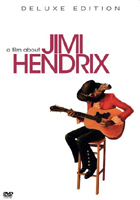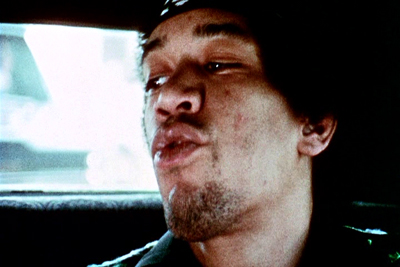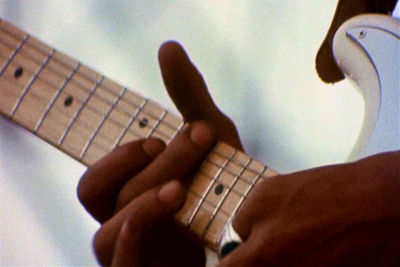 BUY IT AT AMAZON: CLICK HERE!
BUY IT AT AMAZON: CLICK HERE!
STUDIO: Warner Brothers
MSRP: $19.98 RATED: R
RUNNING TIME: 103 Minutes
SPECIAL FEATURES:
• Featurette: "From the Ukelele to the Strat"
• Featurette: "The Making of Dolly Dagger"
• Additional concert performance
Here’s a
revelation for you: Jimi Hendrix may not have been human. In that subset of
humanity composed of musicians, he was revered by those we consider gods: Pete
Townshend, Eric Clapton, Mick Jagger — okay, so worship has waned a bit in the
years since those men were in their primes, but Hendrix himself has remained
firmly on the Mount Olympus of musicianship, despite his crushing lack of
self-confidence.
Jimi Hendrix, the 1973 documentary now
released on DVD, is a distant glimpse of the man, which nevertheless manages
to communicate quite clearly the contrasts that encompassed his life.
The Flick
Jimi Hendrix picks up with its subject’s life
in the latter years of his tour in the military, as he played with bands
composed of his fellow servicemen. After being medically discharged from the
army, Hendrix moved to
group that would have him, playing lead guitar in an array of blues and soul
bands back East. Acquaintances from this period laughingly recall how Jimi got
fired from a number of these groups because his animated playing drew too much
attention away from the lead singer.
This
pre-fame content takes up roughly half of the documentary’s running time.
Through interviews juxtaposed with concert footage, the filmmakers set up a
cognitive dissonance; most of Hendrix’s acquaintances who speak during the
first half describe him as being a self-conscious, shy, low-key, all of which
become hard to believe when the audience sees Hendrix onstage, miming sex with
his guitar, playing lead with his teeth, his right hand moving like a crazed
spider on the fretboard. It’s the ultimate rock metamorphosis, the
quintessential evidence of the apparent magical effects that music can have on
a person.

Jimi was never very good at making love to the camera.
He always missed.
After
slumming around for a while, Hendrix was seen in performance by Chas Chandler
(of The Animals) and invited to come to
Hendrix leapt at the opportunity, uprooted, and crossed the ocean. Here, the
film starts to widen, drawing in interviews with such wildly different people
as Little Richard and Al Hendrix, Jimi’s father. The remarkable thing about all
these new interviewees is that they are all in agreement as to Hendrix’s
character. They approach him differently, from standpoints both critical and
admiring, but all are unified under the opinion that Hendrix was a walking
legend, whether or not he wanted to be, admitted to it, or even believed it.
The
portion of the documentary focusing on Hendrix’s leap to fame is understandably
the most thrilling. The filmmakers show us full-length performances of
"Purple Haze" on British television, and it’s positively
electrifying. Even more so is his rendition of "The Star-Spangled
Banner" at the
Hendrix perform is like watching a man in complete comfort; it’s a sensation
that can’t help but inspire sympathetic reaction in the viewer.
It’s
jarring, then, to see Hendrix himself interviewed in a few rare segments. He is
hesitant to the point of being inarticulate, and often too quiet to understand
clearly. He seems often to be addressing himself in a language that only he
understands. In one of these interviews, a bit taken from an old Dick Cavett
talk show, there are criticisms leveled against his performance of "The
Star-Spangled Banner." Cavett tells him that the way he played the song
was "unorthodox." Hendrix’s reply is quick and defensive, and he
seems not to know what "unorthodox" means. "It wasn’t
unorthodox," he says. "I thought it was beautiful."
Those two
terms are not mutually exclusive, as evidenced by Hendrix’s life, which dealt
heavily in both unorthodoxy and beauty. There have been arguments that Hendrix
was often high or on an acid trip during his public appearances (famously so at
explanation for his lack of lucidity. His former girlfriend, Fayne Pridgon,
shares a great anecdote about how Hendrix always had to take twice as much of
any drug as his friends did, because he was naturally so firmly grounded that
it took half the dose to bring him up to a level of normalcy, and then the
other half to get him high. I’m always hesitant to write off any facet of an
individual as being entirely chemically-induced, though, so I’ll just say this:
Yes, there were drugs, and it’s obvious that Hendrix liked what they did to
him, no matter how they interfered with his public appearance.

"The Star-Spangled Banner" has never been so lovingly throttled.
The
emotional arc of the film comes to a somber close with the various interviewees
discussing Hendrix’s unfortunate death, apparently caused by a drug overdose. The
film was made in 1973, only three years after Hendrix died, so the memories are
still very fresh in the minds of those interviewed. Rather than focusing on the
time of his death, though, each interviewee responds to the question: What did
Jimi mean to you? It’s poignant, but not warm; the impression given is these
people, some of them legends in their own right, are holding their memories of
Hendrix as precious, not to be fully shared with the world. The result is a
denouement that feels barely brushed by Hendrix’s ghost.
As
distancing as that might sound, it’s just about tone-perfect. Hendrix was a man
consumed by his music; he had an all-too-familiar hatred of the business
surrounding music-making, and a downright Hollywood-esque disconnect between
his on- and off-stage personas. He put all his effort into the creation of
music; that’s where he invested his time, his health, his imagination, and we
can assume that’s what he intended to be remembered after his death.
The
structure of Jimi Hendrix is easily followed and unobtrusive. Interviews are
broken up by concert performance footage from a variety of venues. There are
enough different interviews that the filmmakers were able to edit them nice and
thin; there’s no fluff to the exposition. The performances are downright
enthralling, in my opinion, with no flashy tricks in filming. You get to see
Hendrix distilled down to his best, his most memorable performances. The
downside is that while the filming is handled capably, the film stock used for
these performances is of an invariably poor quality by today’s standards. The
use of different stocks, interspersing black-and-white with color, is a bit
distracting at first. It’s alleviated somewhat by the fact that, in most cases,
the stock switching only occurs between segments.
The
filmmakers’ choice that interested me the most about Jimi Hendrix was the
decision not to include any authorial intrusion whatsoever. The audience
doesn’t even hear the interviewers asking questions of their subjects. It
mirrors closely Hendrix’s decisions to put his music up as figurehead, not
himself as a musician.

Using nothing more than lighter fluid and a sulfur match,
Jimi was able to conjure what the primitives called "fire".
Spare and
fervent, Jimi Hendrix is the sort of documentary I would show to
filmgoers unfamiliar with the genre. It’s a study of contrasts in its subject
and in itself, with simple but affecting drama. The concert performances make
for a perfect entry point, especially for fans of rock-and-roll. The
understated methods of the filmmakers elevate the substance over the style,
leaving plenty of room for both Hendrix’s style and his substance.
8.0 out of 10
The Look
It’s
unfortunate, but the footage used in the film is all of a degraded quality.
Scratches and blurs and heavy grain mar the interviews, and the handheld
footage from some of the concerts were never of a good quality to begin with.
The transfer is a fine, 1.85:1 widescreen — none of these problems with the
look stem from the conversion of the content. That just means that all the
blemishes come through extra clearly. It looks all right on a standard TV set,
but on anything capable of high-definition it can start to look pretty
wretched. These problems are the result of limited means, rather than
deliberation, and that, along with the fact that Jimi Hendrix was released
in 1973, makes them easier to forgive.
I’ve also
got to mention the use of color. Hendrix wore some outlandish (by today’s
standards) costumes when performing, full of bright oranges and blues. When
preparing the film for transfer to DVD, the visuals were restored and enhanced,
and the color especially looks great, very bright, very well-defined. It gives
the performance segments (the ones in color, anyway) a Wonderland quality.
6.5 out of 10

This is the face of a man with a personally fulfilling day job.
The Noise
It ain’t
the visuals that you’ll remember from this disc, though. It’s the music. The
soundtrack was remastered by longtime Hendrix engineer Eddie Kramer and remixed
into Dolby 5.1, and, as a result, the concerts sound just great. The guitar is
present right up front, and all the wide ranges that Hendrix coaxed out of it are
captured perfectly. His vocals are a bit muddy, but he was never the most
intelligible singer, anyway.
The
interview segments don’t get the same treatment as the performances, and are
occasionally difficult to hear. Some of the speakers are mumblers, and
individual words get lost under the ambient noise. This is never a problem with
Little Richard, thank goodness.
8.4 out of 10
The Goodies
There are
few extras, but they add up to an additional 75 minutes. There’s a nice
featurette called "From the Ukelele to the Strat" that features
extended and additional interview segments from the film. It’s an additional
hour of friends, family, and fellow musicians reflecting on their memories of
Hendrix. It’s worth watching for the added insight, and the additional
biographical information. The film covers only the period of Hendrix’s rise to
success and his death, but this featurette stretches further back, for those
who are interested.
There’s
also a fascinating short featurette about sound engineer Eddie Kramer, where he
takes the audience through the mixing process of Hendrix’s "Dolly
Dagger". The equipment he used may not be relevant today, but his brief
insights into the theory and practice of mixing are rewarding.
Finally,
there’s an additional concert performance from the July 4, 1970 Atlanta Pop
Festival. The quality of the camera work here is comparable to that of the
segments included in the film.
Also, the
chapter select features each performed song as its own segment, so you can
easily jump to "Hear My Train a-Comin’" if you need a good cry.
7.9 out of 10

Little Richard milks the strategic placement of the microphone for all it’s worth.
The Artwork
This is
just about perfect. It’s a still modified slightly from the film, taken from
the performance of "Hear My Train a-Comin’". The focus is entirely on
Hendrix, but he doesn’t even notice. He’s alone when he’s with his music, a
transported sort of fellow. It’s not heaven, it’s not hell, it’s just not
Earth.
The fact
that the figure is off-center makes a nice change, but the centered placing of
the dominant title and "deluxe edition" tag kind of removes its
impact.
7.2 out of 10
Overall 7.8 out of 10